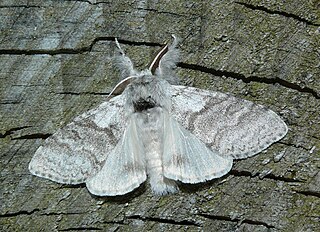Rahona is a genus of moths in the subfamily Lymantriinae. It was named by Paul Griveaud in 1975.

Arctornis is a genus of tussock moths in the family Erebidae, and the sole member of the tribe Arctornithini. The genus was erected by Ernst Friedrich Germar in 1810.

Calliteara is a genus of tussock moths in the family Erebidae. The genus was erected by Arthur Gardiner Butler in 1881.
Cozola is a genus of tussock moths in the family Erebidae. The genus was erected by Francis Walker in 1865.

Dasychira is a genus of tussock moths in the family Erebidae described by Jacob Hübner in 1809. They are well distributed all over Africa, Europe, North America, Madagascar, Japan, China, India, Sri Lanka, Myanmar, Java and Australia.
Decelleria is a monotypic moth genus in the subfamily Lymantriinae erected by Ugo Dall'Asta in 1981. Its only species, Decelleria brachycera, was first described by Cyril Leslie Collenette in 1981. It is found in the Democratic Republic of the Congo.

Eudasychira is a genus of tussock moths in the family Erebidae.

Euproctis is a genus of tussock moths in the family Erebidae described by Jacob Hübner in 1819. Species are cosmopolitan, widespread throughout Palearctic, African, Oriental and Australian regions. Molecular phylogenetic studies indicate that the genus as presently understood comprises a large number of unrelated lineages, only a few of which have names, and is therefore in serious need of revision.

Laelia is a genus of tussock moths in the family Erebidae. The genus was described by Stephens in 1828. Species are well distributed throughout Europe, Japan, China, India, Sri Lanka, Myanmar and Java.

Leucoma is a genus of tussock moths in the family Erebidae. The species are well distributed in Palearctic, Ethiopian, and Oriental regions along with New Britain and Ireland. It was described by Jacob Hübner in 1822.

Olapa is a genus of moths in the family Erebidae. The genus was erected by Francis Walker in 1855.
Parabatella is a monotypic moth genus in the subfamily Lymantriinae erected by Ugo Dall'Asta in 1981. Its only species, Parabatella polyploca, was first described by Cyril Leslie Collenette in 1960. It is found in the Democratic Republic of the Congo.
Viridichira is a genus of moths in the subfamily Lymantriinae. The genus was erected by Ugo Dall'Asta in 1981.
Cyana ellipsis is a moth of the family Erebidae. It was described by Timm Karisch and Ugo Dall'Asta in 2010. It is found in the Democratic Republic of the Congo.
Cyana hecqi is a moth of the family Erebidae. It was described by Timm Karisch and Ugo Dall'Asta in 2010. It is found in the Democratic Republic of the Congo and Rwanda.
Cyana paramargarethae is a moth of the family Erebidae. It was described by Timm Karisch and Ugo Dall'Asta in 2010. It is found in the Democratic Republic of the Congo and Rwanda.
Cyana rufeola is a moth of the family Erebidae. It was described by Timm Karisch and Ugo Dall'Asta in 2010. It is found in Cameroon, the Central African Republic and the Democratic Republic of the Congo.







